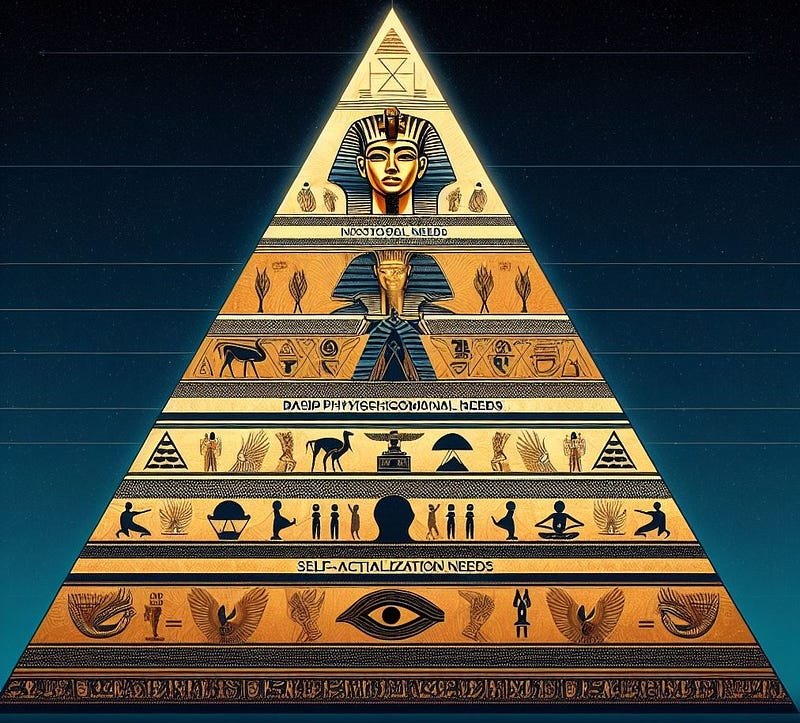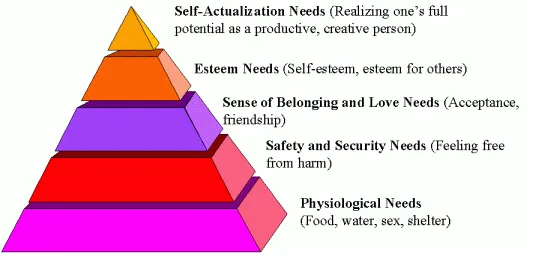
Image created by Bing
“Maslow’s Hierarchy of Needs” was one of the first theories that were triggered by the Hawthorne experiments and are often grouped together and labelled the “Behavioural Theory of Management”.
Behavioural theories have a common goal: a belief that once managers understand human needs, then (and only then) can they begin to direct employees to achieve organisational goals and objectives.
Using scientific methods such as empirical observation and inductive reasoning, behavioural theorists study human behaviour in organisations to establish systems and structures that are most conducive to co-operation and efficiency. Typically, a behavioural theorist will take the following approach to management problem-solving:
- The basic unit of behaviour is an ‘activity’ — an observable performance unit. All behaviour, on and off the job, is a series of activities.
Behaviour is goal-oriented. That is, it is generally motivated by a desire or a need to attain some goal. - To predict behaviour, managers must know which motives or needs of people evoke a particular activity at a specific time. Motives or needs are the “whys” of behaviour: they arouse and maintain activities and determine the general direction of the behaviour of an individual.
- The behaviour of an individual at a particular moment is usually determined by the individual’s strongest need at that moment.
Abraham Maslow was one of the first behaviourists to develop a practical framework to explain the strength of specific human needs. Maslow posited that certain fundamental stages of need and potential growth are common to all human beings. He categorised these into a conceptual framework called the "hierarchy of needs."

Physiological Needs
These are the needs for food, warmth, sleep, sex, and other primarily bodily satisfactions.
Safety Needs
These include the need to be free from actual danger, as well as the need for psychological assurance of security.
Love and Belongingness Needs
These are the basic needs for other people, social acceptance, and group membership, as well as the need to give and receive love and affection.
Esteem Needs
These include the need to have the respect and esteem of others and the need for self-esteem.
Self-Actualisation Needs
These are the needs to fully realise one’s potential— to become what one can become and to actualise the real “self”, which is more than the basic organism.
Maslow theorises that these needs are serial — that is, the lower-level needs have to be satisfied before an individual can be motivated by a higher-level need. Until one level of needs is satisfied, the next higher level is not a significant factor in the individual’s behaviour. For example, basic physiological needs — food, sleep and so forth — must be met before an individual can be motivated by safety needs.
In addition, once a particular set of needs is fulfilled, Maslow postulates that it no longer motivates. This is a crucial point for managers seeking to motivate their employees effectively. Worrying about the lower level needs is not as effective, nor really necessary, since most employees have already satisfied these — a satisfied need no longer motivates. It is more effective to allow employees to fulfil upper-level needs, such as self-esteem and self-actualisation.
The Manager’s Role
In Maslow’s view, the manager's role is to provide people the opportunity to satisfy upper-level needs. Managers must aim for an organisation that helps people fulfil needs for self-esteem and self-actualisation rather than directing attention to already-fulfilled lower-level needs.
Limitations
Maslow’s hierarchy of needs is a useful but limited concept. The major flaw in this behavioural theory is that an individual’s needs and motivations are not static — they change from situation to situation. Lower-level needs, such as the need for physical safety, are immediate and urgent, and they must be constantly satisfied. If they are not constantly satisfied, they will come into play repeatedly as the source of a person’s motivation. For example, sudden physical danger (e.g. a fire) will bring the need for physical safety into sharp focus. Whatever need is uppermost at a given time will become the prime motivating factor.
Summary
- Maslow’s hierarchy of needs posited certain fundamental stages of need and potential growth common to all humans.
- Once a particular set of needs is fulfilled, it no longer motivates.
- The manager's role is to provide people with the opportunity to satisfy upper-level needs.
- Major flaw: an individual’s needs are not static — they change from situation to situation.
Originally published on LearningPages.org
My thanks to @revolverocelotyt, who asked to be notified when I publish new posts.
If you would like to receive notifications, please ask to be included.
You can request cancellation at any time.